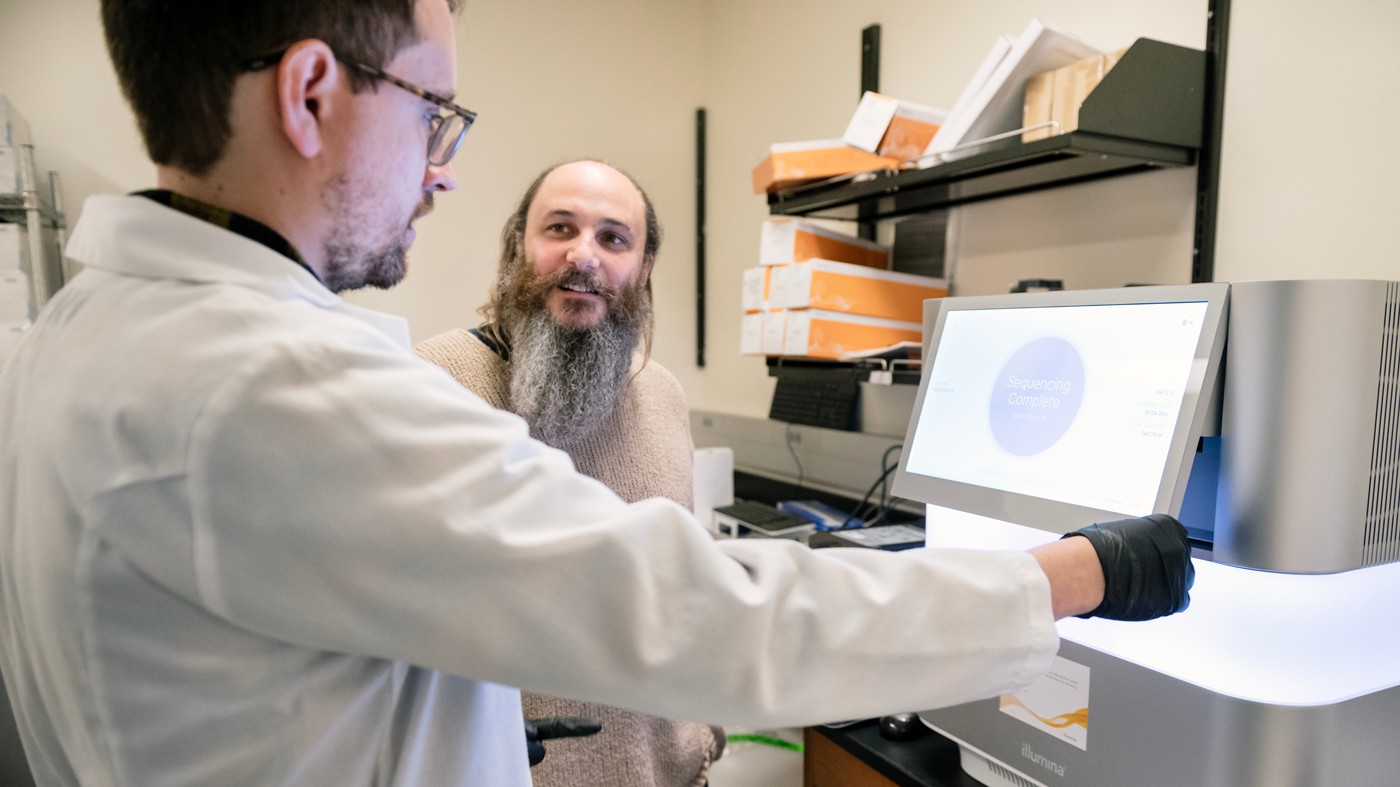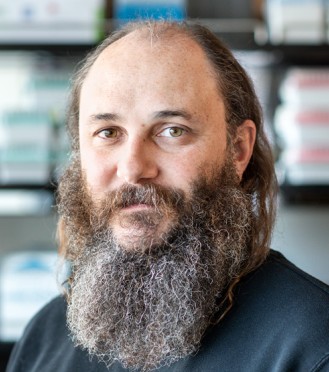Gladstone NOW: The Campaign Join Us on the Journey✕

Seth Shipman (right), Alejandro González-Delgado (left), and their colleagues closely examined never-before-tested retrons, bacterial defense systems that can be leveraged for precise gene editing.
Within bacterial cells, specialized immune systems known as retrons fend off viral attacks. But that’s not all they can do.
Scientists, including Seth Shipman, PhD, at Gladstone Institutes, have shown that retrons also serve an important purpose in the lab: precise DNA editing. In fact, retrons can be combined with CRISPR—the far more famous bacterial-defense-system-turned-gene-editor—to better edit human cells.
Yet, for all their potential to help scientists better understand disease and develop new therapies, only a small number of retrons have been studied. In nature, many thousands of variations exist, some with greater gene-editing powers than others.
In a new study published in Nature Biotechnology, Shipman and his team greatly expand the universe of retron knowledge. They carried out a “census” of 163 never-before-tested retrons and identified many that can edit DNA more quickly and efficiently than those currently used in research.

Shipman and his team tested a large number of retrons in the lab for the first time and showed that many of them can edit DNA more quickly and efficiently in bacteria, phages, and human cells than the ones currently being used.
“The baseline for retron technology has now significantly improved,” says Shipman, lead author of the new study. “In nearly every cell type, we found retrons that were much better editors than what we had started with.”
The scientists tested the new retrons in bacteria, phages (viruses that infect bacteria), and human cells. Some of the newly characterized retrons, they discovered, can edit efficiently enough to be used to treat disease. Their findings also provide an extensive database to start understanding the different properties of different retrons.
Expanding a Toolkit
Ever since the advent of CRISPR more than a decade ago, scientists have used gene editing to more fully understand how cells function and to develop new ways to treat—or even cure—diseases. Retrons, with their natural ability to produce large amounts of DNA to detect invading viruses, take this capability to a new level.
Shipman is among the global leaders in the development of retrons as a biotechnology tool. He uses them as tiny factories inside cells to create the strands of DNA needed for gene editing.
Even though retrons are very common in bacteria, scientists have only been using a handful of retrons first described in the 1980s. A few years ago, researchers in Spain looked through genome databases and identified nearly 2,000 stretches of DNA they predicted to be retrons.
“Nobody had tested these retrons in a lab, so we decided to do just that,” says Asim Khan, co-first author of the new study and a former research associate in Shipman’s lab who is now pursuing his PhD at Columbia University. “We started taking retrons from that list and putting them into cells to see which ones would work and which ones would be useful for technology, and whether there are interesting differences between them.”
In the new work, Shipman’s group carried out lab experiments on a sampling of 163 of the presumed retrons. The retrons were selected to capture the diversity of the Spanish team’s complete list.

The top-performing retrons in this study made correct edits in 30 to 40 percent of human cells, an editing rate that could eventually improve gene therapy for a range of diseases. Seen here are Santiago Lopez (left) and Rebecca Fang (right), two scientists who worked on the study, looking over precise editing rates from retrons.
The researchers engineered E. coli bacteria to contain the code for each predicted retron, and tested whether the sequences were truly retrons that could produce DNA. They confirmed that most of them were indeed functional retrons.
“We then wanted to determine whether any of the new retrons could be better editors than the standard ones we’ve been using, so we measured how much DNA each new retron could produce,” says co-first author of the work Matías Rojas-Montero, a former research associate in the Shipman lab who is pursuing his PhD at UC San Francisco (UCSF). “Our lab previously found that the amount of DNA produced by a retron is a good predictor of how well it will work in genome editing.”
The team discovered that relationships between retrons predicted how much DNA they produced—those that produced the most tended to be related retron systems. Moving forward, this knowledge could help scientists predict how effective other retrons would be for editing.
Better Editors
Once Shipman’s group verified that the retrons could produce DNA in E. coli, they selected 29 retrons to test for their ability to work with gene editing systems in E. coli and phages.
In E. coli, eight of the retrons led to better editing rates than Retron-Eco1, which is currently considered the gold-standard retron for gene editing in bacteria. One retron, from the bacteria Klebsiella variicola, had a 10-fold increase in editing efficiency compared to Eco1. In phages, four retrons were more efficient than Eco1.
Finally, the team tested more than 130 retrons for their ability to carry out gene editing in human cells; 58 of those had higher rates of precise editing than Eco1. The top-performing retrons, they showed, made correct edits in 30 to 40 percent of cells. This editing rate is considered high enough to make a therapeutic difference for many diseases that researchers would like to treat with gene therapy, such as autoimmune diseases and blood disorders.
Shipman and his colleagues are planning additional studies on the new retrons—as well as predicted retrons that didn’t yield DNA—to better understand what parts of the retrons influence their DNA production and ability to work with gene editors. Ultimately, they hope the list provides researchers with new, more effective options when they set out to edit genes using retrons.
“In addition to using the retrons ourselves to edit genomes and introduce genetic variants that are related to diseases, we’ve already been giving these new retrons out to many other labs that are excited about using them,” says Shipman, also an associate professor in the Department of Bioengineering and Therapeutic Sciences at UCSF, as well as a Chan Zuckerberg Biohub Investigator. “As we keep digging deep into the properties of these retrons, we think we’ll be able to engineer and improve them even more.”
For Media
Julie Langelier
Associate Director, Communications
415.734.5000
Email
About the Study
The paper “An experimental census of retrons for DNA production and genome editing” was published in the journal Nature Biotechnology on September 17, 2024. The authors are Asim G. Khan, Matías Rojas-Montero, Alejandro González-Delgado, Santiago C. Lopez, Rebecca F. Fang, Kate D. Crawford, Seth L. Shipman of Gladstone.
The work was supported by the National Science Foundation (MCB 2137692), the National Institute of Biomedical Imaging and Bioengineering (R21EB031393), the National Institute of General Medical Sciences (1DP2GM140917), the L.K. Whittier Foundation, the Pew Biomedical Scholars Program, and Retronix Bio. Some authors also received support from the California Institute of Regenerative Medicine, Berkeley Fellowships for Graduate Study, UCSF Discovery Fellowships, and National Science Foundation Graduate Research Fellowships.
About Gladstone Institutes
Gladstone Institutes is an independent, nonprofit life science research organization that uses visionary science and technology to overcome disease. Established in 1979, it is located in the epicenter of biomedical and technological innovation, in the Mission Bay neighborhood of San Francisco. Gladstone has created a research model that disrupts how science is done, funds big ideas, and attracts the brightest minds.
Featured Experts
Support Discovery Science
Your gift to Gladstone will allow our researchers to pursue high-quality science, focus on disease, and train the next generation of scientific thought leaders.
Gene Editing Strategy Could Treat Hundreds of Inherited Diseases More Effectively
Gene Editing Strategy Could Treat Hundreds of Inherited Diseases More Effectively
Scientists at Gladstone show the new method could treat the majority of patients with Charcot-Marie-Tooth disease.
News Release Research (Publication) Neurological Disease Conklin Lab CRISPR/Gene EditingGenomic Maps Untangle the Complex Roots of Disease
Genomic Maps Untangle the Complex Roots of Disease
Findings of the new study in Nature could streamline scientific discovery and accelerate drug development.
News Release Research (Publication) Marson Lab GenomicsSix Gladstone Scientists Named Among World’s Most Highly Cited Researchers
Six Gladstone Scientists Named Among World’s Most Highly Cited Researchers
The featured scientists include global leaders in gene editing, data science, and immunology.
Awards News Release Corces Lab Doudna Lab Marson Lab Pollard Lab Ye Lab




